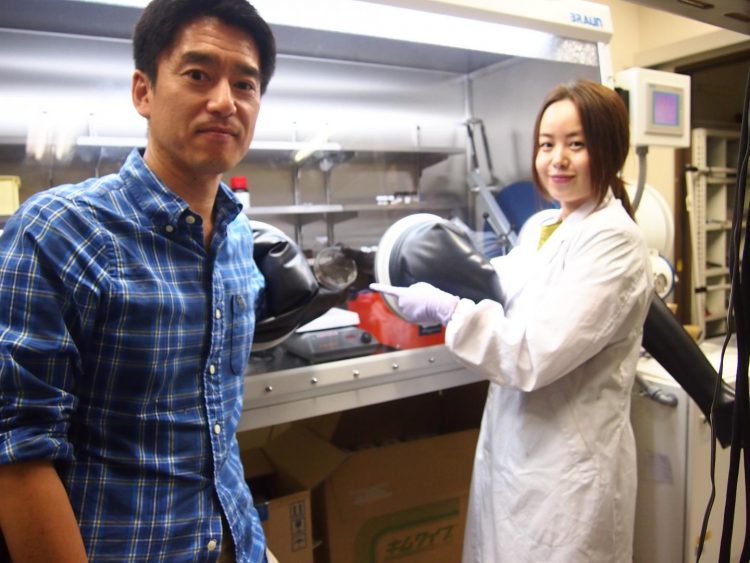Next-generation illumination using silicon quantum dot-based white-blue LED

Professor Ken-ichi Saitow, Natural Science Center for Basic Research and Development, Hiroshima University and Graduate student Yunzi Xin, Graduate School of Science, Hiroshima University, have fabricated an Si QD hybrid LED. Credit: Natural Science Center for Basic Research and Development, Hiroshima University
A hybrid LED is expected to be a next-generation illumination device for producing flexible lighting and display, and this is achieved for the Si QD-based white-blue LED.
For details, refer to “White-blue electroluminescence from a Si quantum dot hybrid light-emitting diode,” in Applied Physics Letters; DOI: 10.1063/1.4921415.
The Si QD hybrid LED was developed using a simple method; almost all processes were solution-based and conducted at ambient temperature and pressure. Conductive polymer solutions and a colloidal Si QD solution were deposited on the glass substrate.
The current and optical power densities of the LED are, respectively, 280 and 350 times greater than those reported previously for such a device at the same voltage (6 V). In addition, the active area of the LED is 4 mm2, which is 40 times larger than that of a typical commercial LED; the thickness of the LED is 0.5 mm.
Professor Saitow stated, “QD LED has attracted significant attention as a next-generation LED. Although several breakthroughs will be required for achieving implementation, a QD-based hybrid LED allows us to give so fruitful feature that we cannot imagine.”
###
Regarding quantum dots (QDs): Semiconductor QDs can produce full-color luminescence through tuning of the particle size. QDs have attracted significant attention as potential components of next-generation solid-state light sources, including LEDs.
Media Contact
All latest news from the category: Physics and Astronomy
This area deals with the fundamental laws and building blocks of nature and how they interact, the properties and the behavior of matter, and research into space and time and their structures.
innovations-report provides in-depth reports and articles on subjects such as astrophysics, laser technologies, nuclear, quantum, particle and solid-state physics, nanotechnologies, planetary research and findings (Mars, Venus) and developments related to the Hubble Telescope.
Newest articles

NASA: Mystery of life’s handedness deepens
The mystery of why life uses molecules with specific orientations has deepened with a NASA-funded discovery that RNA — a key molecule thought to have potentially held the instructions for…

What are the effects of historic lithium mining on water quality?
Study reveals low levels of common contaminants but high levels of other elements in waters associated with an abandoned lithium mine. Lithium ore and mining waste from a historic lithium…

Quantum-inspired design boosts efficiency of heat-to-electricity conversion
Rice engineers take unconventional route to improving thermophotovoltaic systems. Researchers at Rice University have found a new way to improve a key element of thermophotovoltaic (TPV) systems, which convert heat…



